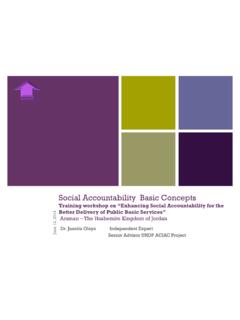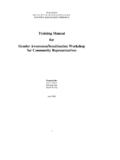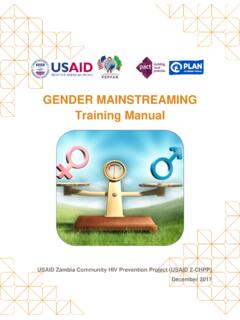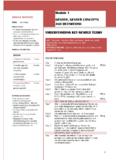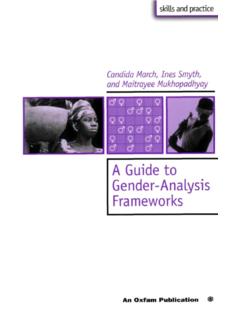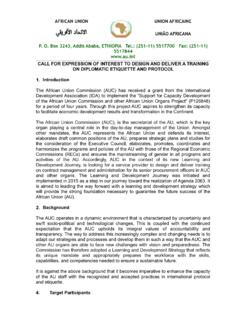Transcription of GENDER MAINSTREAMING IN PRACTICE: A HANDBOOK
1 GENDER MAINSTREAMING IN PRACTICE: A HANDBOOK 1 Acknowledgements This HANDBOOK was produced by the Regional GENDER Programme of the United Nations Development Programme s Regional Bureau for Europe and the CIS (UNDP RBEC). Author: Astrida Neimanis This HANDBOOK has been prepared and finalized with contributions from many people. In particular, the author would like to acknowledge the following individuals for their role in seeing this HANDBOOK through from inception to publication: Shahrbanou Tadjbakhsh, Miroslava Stricova, Zuzana Hlavacova, Dona Abdurazakova and Galina Kalinaeva.
2 Additionally, thanks go to all UNDP GENDER Focal Points in the RBEC region who provided valuable comments to the first draft, and to all participants of the RBEC Sub-regional Workshops on GENDER MAINSTREAMING (June-August 2001), whose insightful comments and suggestions have also been incorporated. There is no copyright attached to this publication. It may be reproduced in whole or in part without prior permission from the United Nations Development Programme. However, the source must be acknowledged. This publication is also available in Russian.
3 This publication is also available on the Internet: xxxxx Cover design by: xxxx Design by: xxxx Layout by: xxxx 2 TABLE OF CONTENTS INTRODUCTION PART I: 10 STEPS TO INTEGRATING GENDER INTO THE POLICY-MAKING PROCESS INTRODUCTION TO PART I STEP 1: A MAINSTREAMING Approach to Stakeholders: Who are the Decision-Makers? STEP 2: MAINSTREAMING a GENDER Agenda: What is the Issue? STEP 3: Moving Towards GENDER Equality: What is the Goal? STEP 4: Mapping the Situation: What Information do we Have? STEP 5: Refining the Issue: Research and Analysis STEP 6: Formulating Policy or Project Interventions from a GENDER Perspective STEP 7: Arguing Your Case: GENDER Matters!
4 STEP 8: Monitoring: Keeping a ( GENDER -Sensitive) Eye on Things STEP 9: Evaluation: How Did We Do? STEP 10: En-gendering Communication PART II: GENDER BRIEFS: A SECTORAL APPROACH TO MAINSTREAMING INTRODUCTION TO PART II MACROECONOMICS AND TRADE Objectives and Justification of Macroeconomic Policy Reproductive Work Budgets Trade Liberalization GOVERNANCE AND PARTICIPATON Governance and Participation at the National Level Local Governance: Decentralization, Community Planning and Service Provision Governance and the Household/Family Participation and Governance in the Private Sector LABOUR Economic Activity and Time Use: Productive and Reproductive Labour Unemployment, Job-seeking and Retraining Occupational Segregation Equal Opportunities and Discrimination Working Conditions and Family-Friendly Policies EDUCATION Equality in Enrolment and Completion Statistics Structural Equality within the Teaching Profession GENDER Roles and Stereotypes.
5 School Curricula and Teacher Training Parent Involvement in Education 3 HEALTH Life Expectancy Incidence of Disease and Other Health Problems Reproductive and Sexual Health Health Sector Reform Access to Health Care GENDER -based Violence POVERTY Defining and Conceptualizing Poverty and GENDER Measuring Poverty Poverty Eradication Initiatives JUSTICE AND HUMAN RIGHTS National Legislation and Legal Rights The Judiciary International Human Rights Obligations Monitoring and Reporting Protection and Complaints Mechanisms SCIENCE, RESEARCH AND INFORMATION AND COMMUNICATION TECHNOLOGIES (ICT) GENDER as a Scientific Variable Statistics Information and Communication Technologies (ICT)
6 Careers in Science and Technology MASS MEDIA Reflection of GENDER Roles and Stereotypes Media Control, Participation and Access ENVIRONMENT AND SUSTAINABLE DEVELOPMENT A Sustainable Global Environment and Approaches to Development Gendered Roles in Environmental Protection The Gendered Impact of Environmental Degradation and Environmental Clean-up DEFENSE, CONFLICT AND PEACE-BUILDING Military and Defense Institutions GENDER in Violent Conflict and War Conflict Resolution, Peace Building and Post-Conflict Situations REFERENCES 4 INTRODUCTION What is GENDER MAINSTREAMING ?
7 As defined by the United Nations, GENDER MAINSTREAMING is: .. the process of assessing the implications for women and men of any planned action, including legislation, policies or programmes, in all areas and at all levels. It is a strategy for making women s as well as men s concerns and experiences an integral dimension of the design, implementation, monitoring and evaluation of policies and programmes in all political, economic and societal spheres so that women and men benefit equally and inequality is not perpetuated.
8 1 GENDER MAINSTREAMING is not only a question of social justice, but is necessary for ensuring equitable and sustainable human development by the most effective and efficient means. Why is GENDER MAINSTREAMING new? GENDER MAINSTREAMING makes a GENDER dimension explicit in all policy sectors. GENDER equality is no longer viewed as a separate question, but becomes a concern for all policies and programmes. Furthermore, a GENDER MAINSTREAMING approach does not look at women in isolation, but looks at women and men - both as actors in the development process, and as its beneficiaries.
9 Significantly, GENDER MAINSTREAMING differs from a women in development (WID) approach in that it takes as its starting point a thorough and rigorous analysis of the development situation, rather than a-priori assumptions about women s roles and problems. Experience has shown that GENDER issues differ by country, region and concrete situation. At the same time, experience has also shown that rigorous, GENDER -sensitive analysis invariably reveals GENDER -differentiated needs and priorities, as well as GENDER inequalities in terms of opportunities and outcomes.
10 GENDER MAINSTREAMING seeks to redress these problems. Given the above, it is clear that a GENDER MAINSTREAMING approach does not necessarily make the need for specific policies, programmes or projects on GENDER equality obsolete. The level of intervention (from basic GENDER sensitivity to comprehensive, targetted GENDER programmes) will depend on the specific needs and priorities revealed by a GENDER -sensitive situation assessment. Finally, as a comprehensive strategy, GENDER MAINSTREAMING should also address the environment (corporate, office) in which policies and programmes are developed and implemented.

